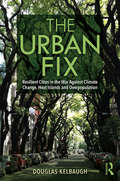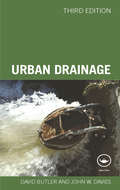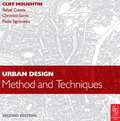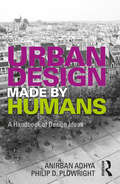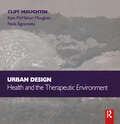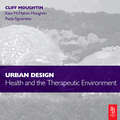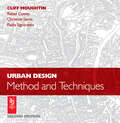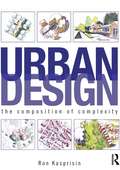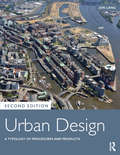- Table View
- List View
The Urban Fix: Resilient Cities in the War Against Climate Change, Heat Islands and Overpopulation
by Douglas KelbaughCities are one of the most significant contributors to global climate change. The rapid speed at which urban centers use large amounts of resources adds to the global crisis and can lead to extreme local heat. The Urban Fix addresses how urban design, planning and policies can counter the threats of climate change, urban heat islands and overpopulation, helping cities take full advantage of their inherent advantages and new technologies to catalyze social, cultural and physical solutions to combat the epic, unprecedented challenges humanity faces. The book fills a conspicuous void in the international dialogue on climate change and heat islands by examining both the environmental benefits in developed countries and the population benefit in developing countries. Urban heat islands can be addressed in incremental, manageable steps, such as planting trees and painting roofs white, which provide a more concrete and proactive sense of progress for policymakers and practitioners. This book is invaluable to anyone searching for a better understanding of the impact of resilient cities in the monumental and urgent fight against climate change, and provides the tools to do so.
Urban Environmentalism: Global Change and the Mediation of Local Conflict
by Peter Brand Michael ThomasA critical examination of urban policies and management practices used to make cities sustainable. With an international perspective, the book describes urban environmental agendas and how they arose in the context of globalization, urban economic restructuring, and the need to make cities competitive. It argues that the environment became an integral part of city development policy, turning attention not only to physical and ecological issues but also to improving the economic performance of cities and the lives of citizens. The authors also go beyond the technical issues to explore the political importance of urban environmentalism, using case studies to illustrate both its international scope and place-specific characteristics which are inexorably influencing city development throughout the world. In connecting the concept to its political effects, the book raises issues such as local democracy, equality and social regulation, all of which are increasingly concerning academics, professionals, environmentalists and city authorities alike.
Urban Environmentalism: Global Change and the Mediation of Local Conflict
by Peter Brand Michael ThomasA critical examination of urban policies and management practices used to make cities sustainable. With an international perspective, the book describes urban environmental agendas and how they arose in the context of globalization, urban economic restructuring, and the need to make cities competitive. It argues that the environment became an integral part of city development policy, turning attention not only to physical and ecological issues but also to improving the economic performance of cities and the lives of citizens. The authors also go beyond the technical issues to explore the political importance of urban environmentalism, using case studies to illustrate both its international scope and place-specific characteristics which are inexorably influencing city development throughout the world. In connecting the concept to its political effects, the book raises issues such as local democracy, equality and social regulation, all of which are increasingly concerning academics, professionals, environmentalists and city authorities alike.
Urban Entomology: Insect and Mite Pests in the Human Environment
by William RobinsonThis is a comprehensive textbook covering all aspects of entomology in the human environment. There is particular emphasis on control and biology of pests. The book provides students of entomology with a clear theoretical and practical foundation in household and structural insect pests.;This book should be of interest to senior undergraduates and masters students in entomology; pest control workers; researchers in the pesticide industry.
Urban Entomology: Insect and Mite Pests in the Human Environment
by William RobinsonThis is a comprehensive textbook covering all aspects of entomology in the human environment. There is particular emphasis on control and biology of pests. The book provides students of entomology with a clear theoretical and practical foundation in household and structural insect pests.;This book should be of interest to senior undergraduates and masters students in entomology; pest control workers; researchers in the pesticide industry.
Urban Drainage, Third Edition
by David Butler John DaviesUrban Drainage has been thoroughly revised and updated to reflect changes in the practice and priorities of urban drainage. New and expanded coverage includes: Sewer flooding The impact of climate change Flooding models The move towards sustainability Providing a descriptive overview of the issues involved as well as the engineering principles and analysis, it draws on real-world examples as well as models to support and demonstrate the key issues facing engineers dealing with drainage issues. It also deals with both the design of new drainage systems and the analysis and upgrading of existing infrastructure. This is a unique and essential textbook for students of water, environmental, and public health engineering as well as a valuable resource for practising engineers.
Urban Drainage, Third Edition
by David Butler John DaviesUrban Drainage has been thoroughly revised and updated to reflect changes in the practice and priorities of urban drainage. New and expanded coverage includes: Sewer flooding The impact of climate change Flooding models The move towards sustainability Providing a descriptive overview of the issues involved as well as the engineering principles and analysis, it draws on real-world examples as well as models to support and demonstrate the key issues facing engineers dealing with drainage issues. It also deals with both the design of new drainage systems and the analysis and upgrading of existing infrastructure. This is a unique and essential textbook for students of water, environmental, and public health engineering as well as a valuable resource for practising engineers.
Urban Design: Street and Square
by Cliff MoughtinThis book, part of a series of four, offers a detailed analysis of urban design, covering the streets, squares and buildings that make up the public face of towns and cities. It outlines the theory of the principal features of urban design from which method is developed and provides a better understanding of the main elements of urban design. This includes the arrangement, design and details of the streets and squares, and the roles they play in city planning.This third edition includes chapters on "Sustainable Urban Design" and "Visual Analysis", introducing the latest theories and influences in the field and bringing greater practical significance to the book. Cliff Moughtin explores the street and square in terms of function, structure and symbolism and examines fine examples in their historical context. These are set against the background of the laws of urban design composition, culled from Renaissance and modern writers.
Urban Design Reader
by Steve Tiesdell Matthew CarmonaEssential reading for students and practitioners of urban design, this collection of essays introduces the 6 dimensions of urban design through a range of the most important classic and contemporary key texts. Urban design as a form of place making has become an increasingly significant area of academic endeavour, of public policy and professional practice. Compiled by the authors of the best selling Public Places Urban Spaces, this indispensable guide includes all the crucial definitions and various understandings of the subject, as well as a practical look at how to implement urban design that readers will need to refer to time and time again. Uniquely, the selections of essays that include the works of Gehl, Jacobs, and Cullen, are presented substantially in their original form, and the truly accessible dip-in-and-out format will enable readers to form a deeper, practical understanding of urban design.
Urban Design Reader
by Steve Tiesdell Matthew CarmonaEssential reading for students and practitioners of urban design, this collection of essays introduces the 6 dimensions of urban design through a range of the most important classic and contemporary key texts. Urban design as a form of place making has become an increasingly significant area of academic endeavour, of public policy and professional practice. Compiled by the authors of the best selling Public Places Urban Spaces, this indispensable guide includes all the crucial definitions and various understandings of the subject, as well as a practical look at how to implement urban design that readers will need to refer to time and time again. Uniquely, the selections of essays that include the works of Gehl, Jacobs, and Cullen, are presented substantially in their original form, and the truly accessible dip-in-and-out format will enable readers to form a deeper, practical understanding of urban design.
Urban Design: Method and Techniques
by Rafael Cuesta Christine Sarris Paola Signoretta J.C MoughtinThis book deals with a wide range of techniques used in the urban design process. It then goes on to relate these techniques to a unique, comprehensive account of method. A method of urban design is developed which has sustainability and environmental protection at the centre of its philosophy. Previously, literature regarding the urban design method has been almost totally neglected; this book introduces the topic to the reader. This revised Second Edition encompasses the latest techniques including the development of geographic information systems and financial techniques which help evaluate projects.A number of techniques are illustrated by example or case study. Where techniques are discussed they are located within the structure of the design process. The book develops a logical framework for a process, which includes problem definition, survey, analysis, concept generation, evaluation and implementation. It is this framework which leads toward the development of an urban design method. This book is a practical guide for students or professionals in the early part of their careers. It is organized so that each chapter provides guidance which readers would have otherwise had to discover for themselves, often with some difficulty.
Urban Design Made by Humans: A Handbook of Design Ideas
by Anirban Adhya Philip D. PlowrightThe design of urban environments is complex and involves diverse needs, organisations, professions, authorities, and communities. It requires relationships to be constructed and sustained between infrastructure, resources, and populations across multiple scales. This can be quite daunting. However, at the core of urban design is a simple idea—our urban spaces are designed to allow people and communities to thrive. For that reason, a good starting point for urban designers is to focus on the way people think when engaging our built environment. This thinking is embodied, developed through the interactions between our mind, body, and the environment around us. These embodied concepts are central to how we see the world, how we move and gather, and how we interact with others. They are also the same ideas we use to design our environments and cities. Urban Design Made by Humans is a reference book that presents 56 concepts, notions, ideas, and agreements fundamental to the design and interpretation of our human settlements. The ideas here parallel those found in Making Architecture Through Being Human but extends them into urban environments. Urban Design Made by Humans distinctly highlights priorities in urban design in how we produce meaningful environments catering to wider groups of people. Each idea is isolated for clarity with short and concise definitions, examples, and illustrations. They are organised in five sections of increasing complexity. Taken as a whole, the entries frame the priorities and values of urban design while also being instances of a larger system of human thinking.
Urban Design Made by Humans: A Handbook of Design Ideas
by Anirban Adhya Philip D. PlowrightThe design of urban environments is complex and involves diverse needs, organisations, professions, authorities, and communities. It requires relationships to be constructed and sustained between infrastructure, resources, and populations across multiple scales. This can be quite daunting. However, at the core of urban design is a simple idea—our urban spaces are designed to allow people and communities to thrive. For that reason, a good starting point for urban designers is to focus on the way people think when engaging our built environment. This thinking is embodied, developed through the interactions between our mind, body, and the environment around us. These embodied concepts are central to how we see the world, how we move and gather, and how we interact with others. They are also the same ideas we use to design our environments and cities. Urban Design Made by Humans is a reference book that presents 56 concepts, notions, ideas, and agreements fundamental to the design and interpretation of our human settlements. The ideas here parallel those found in Making Architecture Through Being Human but extends them into urban environments. Urban Design Made by Humans distinctly highlights priorities in urban design in how we produce meaningful environments catering to wider groups of people. Each idea is isolated for clarity with short and concise definitions, examples, and illustrations. They are organised in five sections of increasing complexity. Taken as a whole, the entries frame the priorities and values of urban design while also being instances of a larger system of human thinking.
Urban Design: Health and the Therapeutic Environment
by Paola Signoretta Kate McMahon Moughtin J.C. Moughtin'Urban Design: Health and the Therapeutic Environment' demonstrates how urban design and planning impact on public health and sustainable development. Moughtin et al. explore the concept of what makes a physically and psychologically ‘healthy’ environment in the context of the paramount need for new homes where living standards are not compromised, in increasingly crowded cities. • Sets out the history and development of the healthy city, from the English spa town to standards of care in Cuba to provide a context for modern urban health development. • Covers a wide range of environmental, ecological, health and epidemiological issues. • Case studies and examples show how health policy and procedure is practically applied to sustainable urban development. 'Urban Design: Health and the Therapeutic Environment' outlines best practice for healthy, sustainable urban design and provides a reference tool for architects, urban designers, landscape architects, health professionals and planners. Emeritus Professor Cliff Moughtin was Professor of Planning in The Queen’s University Belfast and The University of Nottingham. He is author of a number of books including the series of five Urban Design titles for Architectural Press. Kate McMahon Moughtin is a psychotherapist. She is author of Focused Therapy for Organisations and Individuals. She is interested in how literature and environmental infl uences contribute to wellbeing. Paola Signoretta is a human geographer. She is a senior research associate in the Centre for Research in Social Policy, Loughborough University. She is interested in the geographies of health, deprivation and social and financial exclusion.
Urban Design: Health and the Therapeutic Environment
by Paola Signoretta Kate McMahon Moughtin J.C. Moughtin'Urban Design: Health and the Therapeutic Environment' demonstrates how urban design and planning impact on public health and sustainable development. Moughtin et al. explore the concept of what makes a physically and psychologically ‘healthy’ environment in the context of the paramount need for new homes where living standards are not compromised, in increasingly crowded cities. • Sets out the history and development of the healthy city, from the English spa town to standards of care in Cuba to provide a context for modern urban health development. • Covers a wide range of environmental, ecological, health and epidemiological issues. • Case studies and examples show how health policy and procedure is practically applied to sustainable urban development. 'Urban Design: Health and the Therapeutic Environment' outlines best practice for healthy, sustainable urban design and provides a reference tool for architects, urban designers, landscape architects, health professionals and planners. Emeritus Professor Cliff Moughtin was Professor of Planning in The Queen’s University Belfast and The University of Nottingham. He is author of a number of books including the series of five Urban Design titles for Architectural Press. Kate McMahon Moughtin is a psychotherapist. She is author of Focused Therapy for Organisations and Individuals. She is interested in how literature and environmental infl uences contribute to wellbeing. Paola Signoretta is a human geographer. She is a senior research associate in the Centre for Research in Social Policy, Loughborough University. She is interested in the geographies of health, deprivation and social and financial exclusion.
Urban Design: Green Dimensions (Urban Design Ser.)
by Peter Shirley J. C. MoughtinIn Green Dimensions, Cliff Moughtin relates sustainable development and green design to the realm of urban design and development. Examining regional and local frameworks for design and planning, this book shows how sustainable urban design can be implemented on every scale.Working from a strong theoretical base, the author uses case studies and discusses policy developments, in order to challenge the conventional wisdom onsustainable design. The book provides a rounded discussion of the application and suitability of current practice, and predicts future design needs.Updating the reader on topics such as energy efficiency, sustainable city forms and the culture of new urbanism, this completely revised and restructured second edition also includes brand new chapters on the Urban Park and Bio-diversity.
Urban Design: Green Dimensions
by Peter Shirley J. C. MoughtinIn Green Dimensions, Cliff Moughtin relates sustainable development and green design to the realm of urban design and development. Examining regional and local frameworks for design and planning, this book shows how sustainable urban design can be implemented on every scale.Working from a strong theoretical base, the author uses case studies and discusses policy developments, in order to challenge the conventional wisdom onsustainable design. The book provides a rounded discussion of the application and suitability of current practice, and predicts future design needs.Updating the reader on topics such as energy efficiency, sustainable city forms and the culture of new urbanism, this completely revised and restructured second edition also includes brand new chapters on the Urban Park and Bio-diversity.
Urban Design and the British Urban Renaissance
by John PunterAre Britain’s cities attractive places in which to live, work and play? Asking that question, this is a critical review of how the design dimension of the Urban Renaissance strategy was developed and applied, based on expert academic assessments of progress in Britain’s thirteen largest cities. The case studies are preceded by a dissection of New Labour’s renaissance agenda, and concluded by a synthesis of achievements and failings. Exploring the implications of this strategy for the future of urban planning and design, this is a must-read for students, practitioners of these subjects and for all those who wish to improve the quality of the British urban environment.
Urban Design and the British Urban Renaissance
by John PunterAre Britain’s cities attractive places in which to live, work and play? Asking that question, this is a critical review of how the design dimension of the Urban Renaissance strategy was developed and applied, based on expert academic assessments of progress in Britain’s thirteen largest cities. The case studies are preceded by a dissection of New Labour’s renaissance agenda, and concluded by a synthesis of achievements and failings. Exploring the implications of this strategy for the future of urban planning and design, this is a must-read for students, practitioners of these subjects and for all those who wish to improve the quality of the British urban environment.
Urban Design: Method And Techniques
by Rafael Cuesta Christine Sarris Paola Signoretta J.C MoughtinThis book deals with a wide range of techniques used in the urban design process. It then goes on to relate these techniques to a unique, comprehensive account of method. A method of urban design is developed which has sustainability and environmental protection at the centre of its philosophy. Previously, literature regarding the urban design method has been almost totally neglected; this book introduces the topic to the reader. This revised Second Edition encompasses the latest techniques including the development of geographic information systems and financial techniques which help evaluate projects.A number of techniques are illustrated by example or case study. Where techniques are discussed they are located within the structure of the design process. The book develops a logical framework for a process, which includes problem definition, survey, analysis, concept generation, evaluation and implementation. It is this framework which leads toward the development of an urban design method. This book is a practical guide for students or professionals in the early part of their careers. It is organized so that each chapter provides guidance which readers would have otherwise had to discover for themselves, often with some difficulty.
Urban Design: The Composition of Complexity
by Ron KasprisinFor planning to be successful, design must mean more than simply blindly following the dictates of legislation and regulation – yet losing sight of the importance of the design process is all too often exactly what has happened. Ron Kasprisin has written a book for students of planning and urban design that reconnects the process of designing with outcomes on the ground, and puts thinking about design back at the heart of what planners do. The book identifies the elements and principles of composition and explores compositional order and structure as they relate to the meaning and functionality of cities. It discusses new directions and methods, outlines the importance of both buildings and the open spaces between them. Mixing accessible theory, practical examples and carefully designed exercises in composition from simple to complex settings, Urban Design is an essential textbook for classrooms and design studios across the full spectrum of planning and urban studies fields. Not only filled with illustrations and graphics of excellent projects, it gives students tools to enable them to sketch, draw, design and above all, to think.
Urban Design: The Composition of Complexity
by Ron KasprisinFor planning to be successful, design must mean more than simply blindly following the dictates of legislation and regulation – yet losing sight of the importance of the design process is all too often exactly what has happened. Ron Kasprisin has written a book for students of planning and urban design that reconnects the process of designing with outcomes on the ground, and puts thinking about design back at the heart of what planners do. The book identifies the elements and principles of composition and explores compositional order and structure as they relate to the meaning and functionality of cities. It discusses new directions and methods, outlines the importance of both buildings and the open spaces between them. Mixing accessible theory, practical examples and carefully designed exercises in composition from simple to complex settings, Urban Design is an essential textbook for classrooms and design studios across the full spectrum of planning and urban studies fields. Not only filled with illustrations and graphics of excellent projects, it gives students tools to enable them to sketch, draw, design and above all, to think.
Urban Design: The Composition of Complexity
by Ron KasprisinUrban design is a process of establishing a structural order within human settlements; responding to dynamic emergent meanings and functions in a constant state of flux. The planning/design process is complex due to the myriad of on-going (urban) organizational and structural relationships and contexts. This book reconnects the process with outcomes on the ground, and puts thinking about design back at the heart of what planners do. Mixing accessible theory, practical examples, and carefully designed exercises in composition from simple to complex settings, Urban Design is an essential textbook for classrooms and design studios across the full spectrum of planning and urban studies fields. Filled with color illustrations and graphics of excellent projects, it gives students tools to enable them to sketch, draw, design, and above all, to think. This new edition remains focused on instructing the student, professional and layperson in the elements and principles of design composition so that they can diverge from conventional and packaged solutions in pursuit of a meaningful and creative urbanism. This edition builds upon established design principles and encourages the student in creative ways to depart from them as appropriate in dealing with the complexity of culture, space and time dynamics of cities. The book identifies the elements and principles of compositions and explores compositional order and structure as they relate to the meaning and functionality of cities. It discusses new directions and methods, and outlines the importance of both buildings and the open spaces between them.
Urban Design: The Composition of Complexity
by Ron KasprisinUrban design is a process of establishing a structural order within human settlements; responding to dynamic emergent meanings and functions in a constant state of flux. The planning/design process is complex due to the myriad of on-going (urban) organizational and structural relationships and contexts. This book reconnects the process with outcomes on the ground, and puts thinking about design back at the heart of what planners do. Mixing accessible theory, practical examples, and carefully designed exercises in composition from simple to complex settings, Urban Design is an essential textbook for classrooms and design studios across the full spectrum of planning and urban studies fields. Filled with color illustrations and graphics of excellent projects, it gives students tools to enable them to sketch, draw, design, and above all, to think. This new edition remains focused on instructing the student, professional and layperson in the elements and principles of design composition so that they can diverge from conventional and packaged solutions in pursuit of a meaningful and creative urbanism. This edition builds upon established design principles and encourages the student in creative ways to depart from them as appropriate in dealing with the complexity of culture, space and time dynamics of cities. The book identifies the elements and principles of compositions and explores compositional order and structure as they relate to the meaning and functionality of cities. It discusses new directions and methods, and outlines the importance of both buildings and the open spaces between them.
Urban Design: A Typology of Procedures and Products
by Jon LangUrban Design: A Typology of Procedures and Products, 2nd Edition provides a comprehensive and accessible introduction to urban design, defining the field and addressing the controversies and goals of urban design. Including over 50 updated international case studies, this new edition presents a three-dimensional model with which to categorize the processes and products involved: product type, paradigm type, and procedural type. The case studies not only illuminate the typology but provide information that designers can use as precedents in their own work. Uniquely, these case study projects are framed by the design paradigm employed, categorized by procedural type instead of instrumental or land use function. The categories used here are Total Urban Design, All-of-a-piece Urban Design, Plug-in Urban Design, and Piece-by-piece Urban Design.Written for both professionals and those encountering urban design in their day-to-day life, Urban Design is an essential introduction to the field and practice, considering the future direction of the field and what can be learned from the past.
